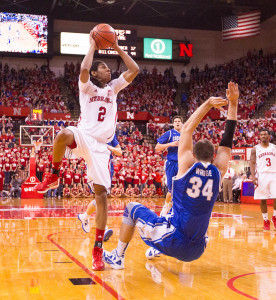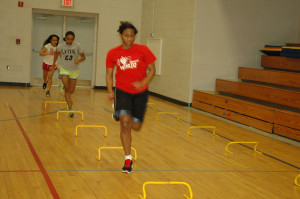Agility for Basketball

Many coaches would argue that strength is the key to success in athletics today and not Agility. However, since most programs incorporate strength training, the edge has shifted to athletic programs that not only weight train but incorporate agility training and drills into their conditioning programs. Of the many important components of fitness within basketball, agility should be at the top of every coach’s list. Agility is defined as the ability to accelerate, decelerate, and change direction quickly while maintaining good body control. Basketball is not played in a straight line, but instead requires constant changes of direction. Therefore, acceleration is an extremely important aspect of agility.
Although agility is a key component, it is often an overlooked component of the game. Basketball is an extremely fast game that requires continual agility. Frequently, the game is played in short bursts of a few feet or less before a change of direction is required. One needs agility to be able to explode when penetrating to the basket, get into position to take a charge, or to catch up to an opponent after a turnover in a fast break situation. An individual, or team, who is extremely agile, will excel on fast breaks, defence, and pressing. Agility training will help gain fractions of a second on that first step and those fractions of a second can be the difference between an uncontested layup and a turnover.
The agility drills outlined below require the ability to stop quickly and accelerate in a different direction and have been proven to be successful in developing agility. However, do not limit yourself only to these agility drills. Changing the order, or making small changes in the drills themselves, will help to keep players mentally fresh. Make sure to consider the concept of specificity when designing the agility training for your basketball program. The footwork encountered by a point guard is going to be different from that of a forward or center. You may want to divide your players into groups based on the positions that they play on the basketball court. Agility training will help your team win more games but it can also have a very positive psychological effect on the athlete. The players will approach the game with more confidence in their physical ability.
Agility Ladder

Arguably the best and most popular agility drill is the “ladder”. If you are not familiar or do not have an agility ladder, pick one up immediately! The agility ladder offers a multitude of benefits for basketball players. The purpose includes, but is not limited to, proper knee bend and action, peripheral vision, flexibility, footwork, foot quickness, hip flexibility, plyometric benefits, and improved change of direction. When completing the ladder drills make sure the players keep their head and eyes focused straight ahead. They should concentrate on getting their feet up off the ground and then back down as quickly as possible.
One drill using the ladder is “Every Other Hole”. Players begin by running forward through rungs using proper knee bend and action, with a slight forward lean. Hit every other rung on the right side with the right foot; hit every other hold on left side with left foot. There is a tendency not to use the arms. Coaches should remind the players to keep their arms at a 90 degree angle and to use a good repetitive, pumping arm action. Players should rest 30 seconds between each repetition or once all players have gone through.
“Double Chop’s” main focus is to improve foot quickness. In this variation, the feet alternate rapidly right-left into each hole, along with the continual arm pumping action.
The “lateral step double chop” and “lateral step with quad chop” will develop foot quickness while improving your players’ ability to slide their feet and allow them to become better defenders. Players will run laterally through the rungs, using a proper defensive stance, while hitting every hole. Go one direction leading with the left foot and come back in the other direction leading with the right foot (face the same way). Remind your players to keep their shoulders and hips squared with their palms up. “Quad chop” has the same coaching points but have players chop their feet twice in each hole.
“Bunny Hop” simulates a player grabbing a rebound and improving their vertical jump. They can jump in every hole or with their feet together, hop diagonally over the ladder. Key coaching point; spend a minimum amount of time on the ground. Arms should be pumped at the same time during each hop and extended overhead like grabbing a rebound.
Some other ladder drills include the “Icky Shuffle”, “Ali shuffle” “Backwards”, “Hop Scotch”, “In and Out” and “Front Back Shuffle”. For more information on these drills, please contact us.
Lane Agility Drill
The next drill to incorporate into your agility training is known as the “Lane Agility Drill”. This drill is now used at the NBA draft combine. The drill should be done using the lane and using cones or discs. Discs of flexible rubber are preferred as there is less chance of injury due to the lower height and less pointed surface. Drills should be done at full speed using the correct form. Emphasize good acceleration and deceleration between cones/discs. Cones should not be run into or knocked over while performing the drills (Pushups make a great penalty).
The drill starts by having player start on the right side of the square and accelerate forward. Then, the player’s breakdown and defensive slide to the next disc. Next, players backpedal to the next disc and defensive slide to the fourth disc. Players then touch the disc and repeat the process. Make sure your players are facing the proper direction when doing the slides. Make certain players do not cross their feet during the shuffle. This drill will not only improve footwork but also help with hip flexibility and build strength in the groin area.
Here are some variations that you can also incorporate using the same setup – “Four Corner Comeback”, “4 corner drop”, and “4 corner square in”.
It is a good idea to use a stopwatch to record the players’ times. Strive for time improvement. Also, a relay race competition allows the players to compete and adds fun to the drill.
Wave Drill
A great agility drill for your entire team is the “Wave Drill”. In this drill, set up 4 lines of players with 3-4 in each line facing the coach. Using the coach’s signal and voice, players will react to the hand movement of the coach. Players will slide right and left using sliding steps, while maintaining a good defensive stance. Stress no crossing over and to push off with the inside of the opposite foot when sliding. Players should maintain palms up during the shuffle steps. Make sure players keep their heads up and tails down.
Once players have the drill down, try incorporating different moves like jumping, hopping, running in place, quarter, half, and full turns. To make the drill even more game like, add in the following – players dive on the floor for a pretend loose ball and get back on their feet as quickly as possible and take a pretend charge by falling backwards and arising rapidly.
Although this drill is usually done with the entire team, change things up by only having one group (3-4 players) go at a time for approximately 30 seconds and when a whistle blows have them sprint to the back of the line or straight ahead past the coach. This allows for more individualized attention and instruction.
Coaches all agree that teams which are successful execute the fundamentals well. These drills simulate various game conditions. By completing the drills mentioned above, your team will see improvement on both the offensive and defensive sides of the court. As coaches, it is imperative that you understand the design and purpose of the drills can effectively communicate and administer the drill, scheduling of the drills and how it fits into your practice plans for pre-season and week-to-week game preparation, how the drill is carried onto the playing court, and how to evaluate the drill.





